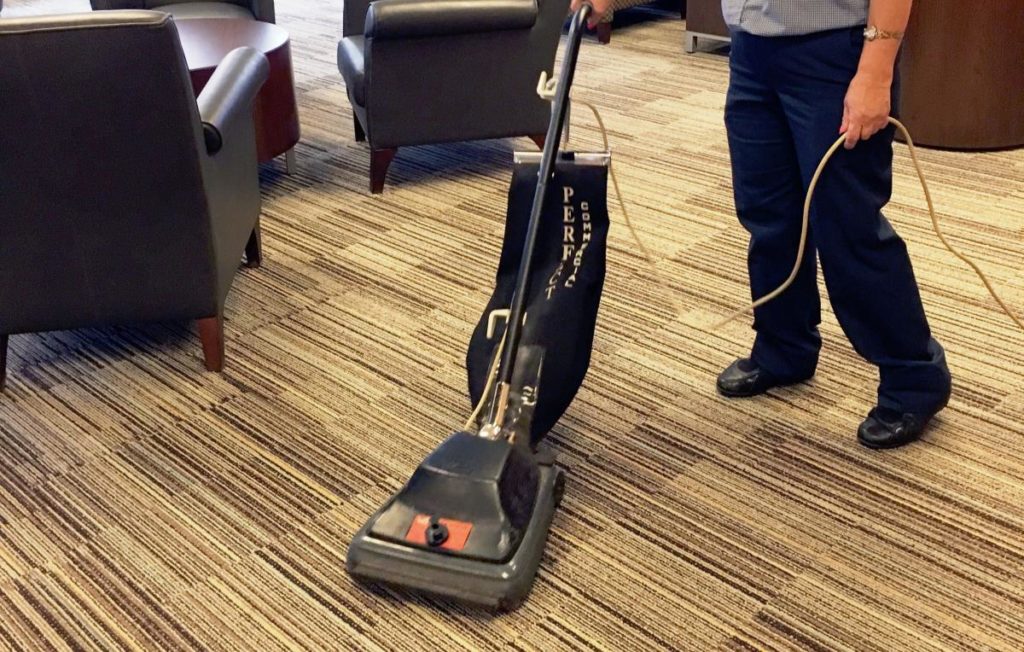Each year, approximately 4.7 billion pounds of carpet ends up in landfills, taking an estimated 1,000 years to degrade. The Institute of Inspection Cleaning and Restoration Certification (IICRC) highlights four strategies for proper carpet maintenance. These strategies will help facility managers reduce their building’s environmental footprint by extending the life of carpets and keeping them out of landfills prematurely.
Regular maintenance is essential to preserving any asset, such as your carpet. The number one way to make sure your carpet lasts a long time is to clean it correctly and on a regular basis.
The IICRC recommends the following carpet maintenance strategies to extend the life of your carpet:
1. Use entryway matting
When it comes to entryway matting, the bigger the better. There must be room for at least two steps with each foot, preferably three, to sufficiently wipe soil from feet before encountering the installed carpet. A mat with a nylon face and vinyl back is best for moisture and oils absorption, combined with the resiliency necessary to collect a quantity of particle soil. The IICRC suggests a rental mat be considered, since that guarantees frequent maintenance. Place entry mats on hard surfaces rather than on carpet where they can trap moisture or cause plasticizer migration.
2. Clean spots immediately
To get the most out of your carpet, make sure to remove spots and spills immediately, reducing the likelihood of a permanent stain. When selecting a cleaning solution, consider using an environmentally friendly cleaning chemical. According to the Environmental Protection Agency (EPA), choosing less hazardous products with positive attributes such as low water use, biodegradability, low toxicity, reduced packaging, low lifecycle energy use and low volatile organic compound (VOC) content can minimize the impact on the environment and contribute to improved air quality.
3. Vacuum daily
The sooner you collect soils from the surface, the easier it is to remove them, so make sure you vacuum daily. For most carpet you should use an upright vacuum with brush agitation, unless your canister vacuum is particularly well designed. The wider the head, the more efficient. Proper and consistent vacuuming is the single most effective means of keeping carpet clean. By following a routine vacuuming schedule, 90 to 95 percent of all dry soil by weight can be removed effectively.
Regular vacuuming also contributes to improved air quality by keeping particulates, such as dust and allergens, out of the air we breathe. Vacuuming effectively sucks up these particulates and keeps them from being recirculated back into the air.
4. Conduct periodic deep cleans
In addition to frequent vacuuming, your facility should also conduct periodic deep cleans on a semi-annual basis to help restore your carpet to its original condition and maintain peak performance. If your facility does not own professional carpet cleaning equipment, consider hiring a professional cleaner to do the job for you. Deep cleans involve an extraction method that removes the accumulation of deep-down soil and residue left behind by other cleaning methods. Pay greater attention to entry-way areas, deep cleaning these areas on a quarterly basis at a minimum.
When the time comes to replace your carpet, consider recycling it instead of throwing it away. There are many options when it comes to recycling your carpet and depending on its condition, it may even be able to be reused. The Carpet America Recovery Effort (CARE) is a great resource when your facility is ready to get rid of its carpet. In 2012, its members diverted 351 million pounds of post-consumer carpet from landfills and recycled 294 million pounds of that carpet.
The IICRC is a standard-development organization that establishes best practices and offers certification for commercial carpet care professionals.

